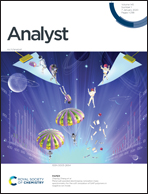Amphiphilic ligand modified gold nanocarriers to amplify lanthanide loading for ultrasensitive DELFIA detection of Cronobacter†
Abstract
Conventional dissociation-enhanced lanthanide (Ln3+) fluoroimmunoassays (DELFIAs) using Ln3+ chelate-labeled antibodies as molecular probes exhibit limited sensitivity because of their relatively low Ln3+ labeling ratio per biomolecule. Herein, we applied gold nanoflowers (AuNFs) as amplified nanocarriers to increase the Ln3+ labeling ratio in a single molecular binding event for improving the sensitivity of traditional DELFIA. Two thiolated amphiphilic ligands (thiolated ethylenediaminetetraacetic acid (EDTA) and thiolated acylhydrazine-terminated ligands), consisting of a hydrophobic alkane chain, oligo(ethylene glycol) unit, and functional terminal of the EDTA or acylhydrazine group, were designed for the surface modification of AuNFs. The resultant ligand-coated AuNFs exhibited dual functions of Ln3+ chelation via the EDTA group and oriented attachment of antibodies via the acylhydrazine group. By utilizing 80 nm AuNFs as amplified carriers, we demonstrated that the maximum Eu3+ loading amount reached 1.07 × 104 Eu3+ ions per AuNF, which is approximately two to three orders of magnitude higher than that of traditional molecular probes, thereby amplifying the luminescence signal and enhancing the sensitivity of DELFIA. By combining a magnetic-mediated sandwich-type DELFIA method, the designed amplified AuNF nanoprobes achieved an ultrasensitive luminescence detection of Cronobacter muytjensii with a limit of detection (LOD) of 1.2 × 102 cfu mL−1 in a powdered infant formula. This LOD value was ca. 230-fold lower than that of the traditional colorimetric immunoassay. The designed signal amplification strategy using bifunctional ligand-modified AuNFs as enhanced Ln3+ nanocarriers provided a huge potential for building various ultrasensitive luminescence immunoassays for in vitro biodetection.



 Please wait while we load your content...
Please wait while we load your content...